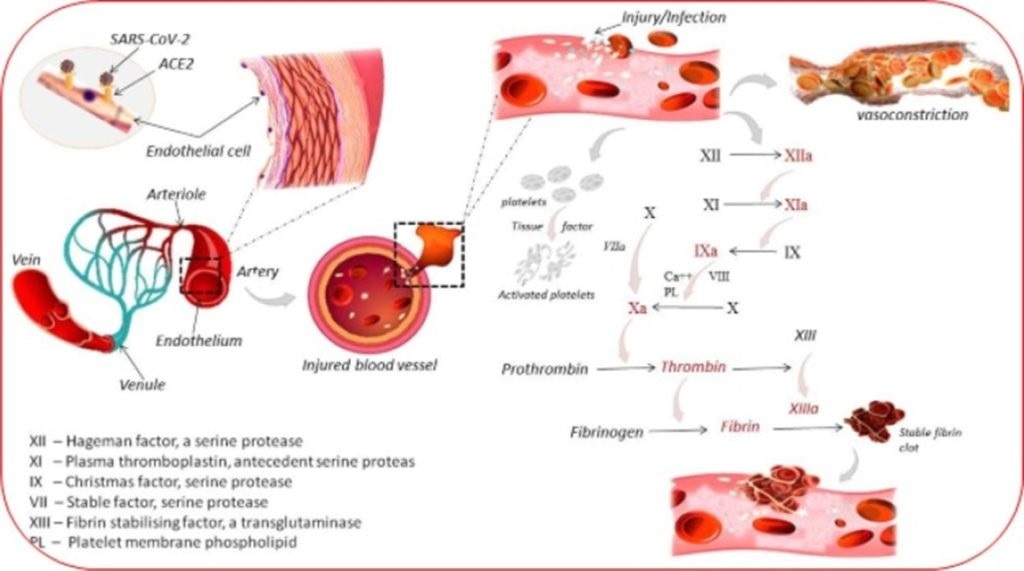Driven by the mystery of the blood clots reported in both living and deceased COVID-19 patients, researchers from Shoolini University, India, dig deeper into the pathogenesis of COVID-19 and other similar viral diseases, looking for ways in which these clots could be formed. They propose a robust hypothesis, taking our understanding of clotting-related problems in COVID-19 one step further and opening doors to potential targeted therapies.

Soon after its emergence in December 2019, COVID-19, caused by the novel coronavirus SARS-CoV-2, rapidly spread worldwide resulting in a global pandemic within weeks and halting lives. Thus, early on, as most activities in the world shut down, attempts to understand SARS-CoV2 and COVID-19 kicked off in full swing.
SARS-CoV-2 was initially thought to be a respiratory pathogen, causing flu-like symptoms such as dry cough, sore throat, fever, and weakness. But over time several non-respiratory symptoms cropped up as well. One symptom gaining increasing attention was the blood clotting reported both in living and deceased patients. In several cases, the blood clots blocked normal blood flow, leading to stroke, organ failure, and even death. Yet, the mechanism of formation of these clots remain shrouded in a certain mystery.
As part of the continued attempt to clarify the mechanism, a team of researchers from Shoolini University, India, dove into the pathogenesis of SARS-CoV-2. Speaking of what inspired them, assistant professor at the university and lead scientist in the team, Dr. Pradeep Kumar, says: “Statements in the vein of ‘mysterious blood clots have been observed in COVID-19 patients’ were being made in newspapers and medical case reports. The blood clots were reported as mysterious because their cause is unknown. This fueled our interest to dig deeper.” Their conclusions are published in Medical Hypotheses.
SARS-CoV-2 primarily enters through the nose and mouth and moves to the lung. It binds to the angiotensin converting enzyme 2 (ACE2) receptor on the cells of these organs and enters the cells. In the cells, it releases its RNA, which then initiates its replication process, leading to infection. Interestingly, the ACE2 receptor is also harbored by other cells in the body, such as the kidneys, heart, intestine, and endothelial cells (or cells lining blood vessels). COVID-19 has been known to affect these organs in some cases.
Based on this knowledge, the team from Shoolini formulated their hypothesis: Upon entering the body, the virus can enter our circulation system. There, it recognizes and interacts with the widely expressed ACE2 receptor on endothelial cells. As it enters the endothelial cells and begins its replication process, it causes infection, which triggers an immune response and therefore, inflammation. It also injures the blood vessel lining. To repair the blood vessel, clotting and coagulating pathways activate. However, in the presence of inflammation, these pathways can go awry, leading to the formation of clots within the blood vessels, which can block the vessels at that site or travel down to other organs, such as the heart or brain, to cause fatal strokes and heart attacks.
Meanwhile, when the virus binds to the ACE2 receptor on the endothelial cells, the receptor is deactivated. Since the receptor normally protects endothelial cell function, its unavailability can help with the injuries and lead to an imbalance in the recruitment of platelets and clotting factors. This can enhance coagulation and clotting.
This hypothesis is based on a robust literature review of cases reporting similar mechanisms in relation to other influenza-like and respiratory viruses, and papers reporting post-mortem observations on COVID-19 patients. So, although it remains to be verified, it is an important step in unraveling the mystery of blood clotting in COVID-19.
Explaining the long-term implications of their study, Dr. Kumar says: “Our work will help us to understand in depth the diverse manifestations and pathophysiologies of COVID-19, which can eventually direct us towards developing targeted therapies to treat it and allied viral diseases.”
Indeed, such analyses bring hope in these dark times.
Video Credit: Shoolini University
Shoolini University
Biswas, S., et al. (2021) Blood clots in COVID-19 patients: Simplifying the curious mystery. Medical Hypotheses. doi.org/10.1016/j.mehy.2020.110371.
Posted in: Medical Research News | Disease/Infection News
Tags: ACE2, Angiotensin, Blood, Blood Vessel, Blood Vessels, Brain, Cell, Coronavirus, Cough, Endothelial cell, Enzyme, Fever, Flu, Heart, Immune Response, Inflammation, Influenza, Pandemic, Pathogen, Platelets, Receptor, Respiratory, RNA, SARS, SARS-CoV-2, Sore Throat, Stroke, Throat, Virus
Source: Read Full Article
